Karl Ernst von Baer
Karl Ernst Ritter[2] von Baer Edler[3] von Huthorn (28 February [O.S. 17 February] 1792 – 28 November [O.S. 16 November] 1876) was a Baltic German scientist and explorer. Baer is also known in Russia as Karl Maksímovich Ber (Russian: Карл Макси́мович Бэр).
Karl Ernst von Baer ForMemRS | |
|---|---|
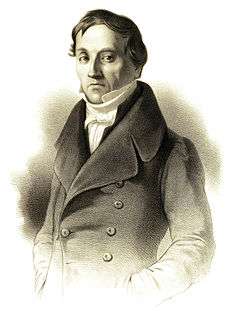 | |
| Born | 28 February [O.S. 17] 1792 Piep Msnor, Piep, Kreis Jerwen, Governorate of Estonia, Russian Empire (in present-day Piibe, Lääne-Viru County, Estonia) |
| Died | 28 November [O.S. 16 November] 1876 (aged 84) Dorpat, Kreis Dorpat, Governorate of Livonia, Russian Empire (present-day Tartu, Tartu County, Estonia) |
| Nationality | Baltic German |
| Alma mater | Imperial University of Dorpat |
| Known for |
|
| Scientific career | |
| Fields | Biology, embryology, geology, meteorology, geography |
| Institutions | Imperial University of Dorpat, University of Königsberg, Russian Academy of Sciences, Russian Geographical Society |
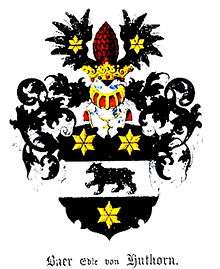
Baer was a naturalist, biologist, geologist, meteorologist, geographer, and a founding father of embryology. He was an explorer of European Russia and Scandinavia. He was a member of the Russian Academy of Sciences, a co-founder of the Russian Geographical Society, and the first president of the Russian Entomological Society, making him a distinguished Baltic German scientist.
Life
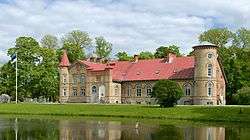
Karl Ernst von Baer was born into the Baltic German noble Baer family (et) in the Piep Manor (et), Jerwen County, Governorate of Estonia (in present-day Lääne-Viru County, Estonia), as a knight by birthright. His family was of Westphalian origin and originated in Osnabrück. He spent his early childhood at Lasila manor, Estonia.[4][5][6][7] Many of his ancestors had come from Westphalia. He was educated at the Knight and Cathedral School in Reval (Tallinn) and the Imperial University of Dorpat (Tartu), each of which he found lacking in quality education. In 1812, during his tenure at the university, he was sent to Riga to aid the city after Napoleon's armies had laid siege to it. As he attempted to help the sick and wounded, he realized that his education at Dorpat had been inadequate, and upon his graduation, he notified his father that he would need to go abroad to "finish" his education. In his autobiography, his discontent with his education at Dorpat inspired him to write a lengthy appraisal of education in general, a summary that dominated the content of the book. After leaving Tartu, he continued his education in Berlin, Vienna, and Würzburg, where Ignaz Döllinger introduced him to the new field of embryology.
In 1817, he became a professor at Königsberg University (Kaliningrad) and full professor of zoology in 1821, and of anatomy in 1826. In 1829, he taught briefly in St Petersburg, but returned to Königsberg. In 1834, Baer moved back to St Petersburg and joined the St Petersburg Academy of Sciences, first in zoology (1834–46) and then in comparative anatomy and physiology (1846–62). His interests while there were anatomy, ichthyology, ethnography, anthropology, and geography. While embryology had kept his attention in Königsberg, then in Russia von Baer engaged in a great deal of field research, including the exploration of the island Novaya Zemlya. The last years of his life (1867–76) were spent in Dorpat, where he became a leading critic of Charles Darwin.[8]
Contributions
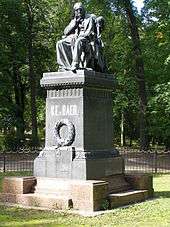
Embryology
von Baer studied the embryonic development of animals, discovering the blastula stage of development and the notochord. Together with Heinz Christian Pander and based on the work by Caspar Friedrich Wolff, he described the germ layer theory of development (ectoderm, mesoderm, and endoderm) as a principle in a variety of species, laying the foundation for comparative embryology in the book Über Entwickelungsgeschichte der Thiere (1828). In 1826, Baer discovered the mammalian ovum. The human ovum was first described by Edgar Allen in 1928. In 1827, he completed research Ovi Mammalium et Hominis genesi for St Petersburg's Academy of Science (published at Leipzig[10][11]). In 1827 von Baer became the first person to observe human ova.[12][13] Only in 1876 did Oscar Hertwig prove that fertilization is due to fusion of an egg and sperm cell.[14]
von Baer formulated what became known as Baer's laws of embryology:
- General characteristics of the group to which an embryo belongs develop before special characteristics.
- General structural relations are likewise formed before the most specific appear.
- The form of any given embryo does not converge upon other definite forms, but separates itself from them.
- The embryo of a higher animal form never resembles the adult of another animal form, such as one less evolved, but only its embryo.
Evolution
From his studies of comparative embryology, Baer had believed in the transmutation of species but rejected later in his career the theory of natural selection proposed by Charles Darwin. He produced an early phylogenetic tree revealing the ontogeny and phylogeny of vertebrate embryos.[15]
In the fifth edition of On the Origin of Species published in 1869, Charles Darwin added a Historical Sketch giving due credit to naturalists who had preceded him in publishing the opinion that species undergo modification, and that the existing forms of life have descended by true generation from pre-existing forms. According to Darwin:
- "Von Baer, towards whom all zoologists feel so profound a respect, expressed about the year 1859... his conviction, chiefly grounded on the laws of geographical distribution, that forms now perfectly distinct have descended from a single parent-form."[16]
Baer believed in a teleological force in nature which directed evolution (orthogenesis).[17][18]
Other sciences
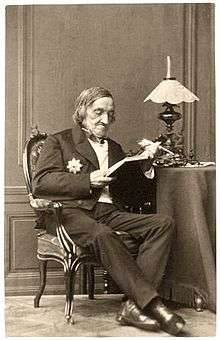
The term Baer's law is also applied to the unconfirmed proposition that in the Northern Hemisphere, erosion occurs mostly on the right banks of rivers, and in the Southern Hemisphere on the left banks. In its more thorough formulation, which Baer never formulated himself, the erosion of rivers depends on the direction of flow, as well. For example, in the Northern Hemisphere, a section of river flowing in a North-South direction, according to the theory, erodes on its right bank due to the coriolis effect,[19] while in an East-West section there is no preference. However, this was repudiated by Albert Einstein's tea leaf paradox.
Baer was interested in the northern part of Russia, and explored Novaya Zemlya in 1837, collecting biological specimens. Other travels led him to the Caspian Sea, the North Cape, and Lapland. He was one of the founders of the Russian Geographical Society.[20]
He was a pioneer in studying biological time – the perception of time in different organisms.[21]
Awards and distinctions
In 1849, he was elected a foreign honorary of the American Academy of Arts and Sciences.[22] He was elected a foreign member of the Royal Swedish Academy of Sciences in 1850. He was the president of the Estonian Naturalists' Society in 1869–1876, and was a co-founder and first president of the Russian Entomological Society.[23][24][25][26] In 1875, he became a foreign member of the Royal Netherlands Academy of Arts and Sciences.[27]
Legacy
A statue honouring him can be found on Toome Hill in Tartu, as well as at Lasila manor, Estonia, and at the Zoological Museum in St Petersburg, Russia. Before the Estonian conversion to the euro, the 2-kroon bank note bore his portrait. Baer Island in the Kara Sea was named after Karl Ernst von Baer for his important contributions to the research of arctic meteorology between 1830 and 1840.[28] A duck, Baer's pochard, was also named after him.
Works
- Karl Ernst von Baer, Gregor von Helmersen. Beiträge zur Kenntniss des Russischen Reiches und der angränzenden Länder Asiens, 2 vols. Kaiserlichen Akademie der Wissenschaften, 1839. Google Books.
- Karl Ernst von Baer, Welche Auffassung der lebenden Natur ist die richtige?, Berlin, 1862[29]
References
- Carl Arvid von Klingspor (1882). Baltisches Wappenbuch. Stockholm. p. 111. ISBN 978-0-543-98710-5. Retrieved 15 April 2019.
- Regarding personal names: Ritter is a title, translated approximately as Sir (denoting a Knight), not a first or middle name. There is no equivalent female form.
- Regarding personal names: Edler is a rank of nobility, not a first or middle name. The female form is Edle.
- K. J. Betteridge (1981). "An historical look at embryo transfer". Reproduction. 62 (1): 1–13. doi:10.1530/jrf.0.0620001. PMID 7014855.
Three years later, the Estonian, Karl Ernst von Baer, finally found the true mammalian egg in a pet dog (von Baer, 1827).
- Karl Clausberg (2006). "Karl Ernst von Baer". Zwischen den Sternen: Lichtbildarchive. Was Einstein und Uexküll, Benjamin und das Kino der Astronomie des 19. Jahrhunderts verdanken (in German). Berlin: Akademie Verlag. p. 47.
...- dreizehn Jahre später von dem berühmten Estländer Biologen Karl Ernst von Baer...
- J.M.S. Pearce, M.D. (2010). "Evolution from recapitulation theory to Neural Darwinism". Hektoen International. A Journal of Medical Humanities. 2 (2). Archived from the original on 29 March 2012.
- Hein, Ants (2009). Eesti Mõisad - Herrenhäuser in Estland - Estonian Manor Houses (in Estonian, German, and English). Tallinn: Tänapäev. p. 126. ISBN 978-9985-62-765-5.
- Alexander Vucinich (1988). Darwin in Russian thought. University of California Press. pp. 92–99. ISBN 978-0-520-06283-2. Retrieved 1 September 2011.
- Kõik algab munast Archived 6 September 2012 at Archive.today
- "Bibliographic Index - Baer Carl". Archived from the original on 21 May 2006.CS1 maint: BOT: original-url status unknown (link) via | Google Translate
- "Biography Karl Maximovych". Archived from the original on 19 March 2008.CS1 maint: BOT: original-url status unknown (link) via | Google Translate
- Cobb M (2012). "An amazing 10 years: the discovery of egg and sperm in the 17th century". Reprod Domest Anim. 47 (Suppl 4): 2–6. doi:10.1111/j.1439-0531.2012.02105.x. PMID 22827343.
- ""Conclusio" from Carl Ernst von Baer's De Ovi Mammalium et..." (jpeg).
- Clift D, Schuh M (2013). "Restarting life: fertilization and the transition from meiosis to mitosis (Box 1)". Nature Reviews Molecular Cell Biology. 14 (9): 549–62. doi:10.1038/nrm3643. PMC 4021448. PMID 23942453.
- Brauckmann, Sabine (2012). "Karl Ernst von Baer (1792-1876) and Evolution". Int. J. Dev. Biol. 56 (9): 653–660. doi:10.1387/ijdb.120018sb. PMID 23319342.
- "The Origin of Species". Preface to the Third Edition.
- Barbieri, Marcello. (2013). Biosemiotics: Information, Codes and Signs in Living Systems. Nova Science Publishers. p. 7. ISBN 978-1600216121
- Jacobsen, Eric Paul. (2005). From Cosmology to Ecology: The Monist World-view in Germany from 1770 to 1930. p. 100. Peter Lang Pub Inc. ISBN 978-0820472317
- Zoltan, Balla (2007). "The Influence of the Coriolis Force on Rivers and the Baer Law. Historical Review" (PDF). Geological Institute of Hungary. pp. 53–62. Retrieved 16 May 2017.
- Founders of the Society
- Karl Ernst von Baer, Welche Auffassung der lebenden Natur ist die richtige?, Berlin, 1862
- "Book of Members, 1780-2010: Chapter B" (PDF). American Academy of Arts and Sciences. Retrieved 5 May 2011.
- Hodgson, Geoffrey M. (2001). How economics forgot history: the problem of historical specificity in social science. New York: Routledge. p. 331. ISBN 978-0-415-25717-6.
- Barbieri, Marcello (2007). Biosemiotics: Information, Codes and Signs in Living Systems. Nova Publishers. p. 6. ISBN 978-1-60021-612-1.
- Lockwood, Michael (2005). The labyrinth of time: introducing the universe. Oxford [Oxfordshire]: Oxford University Press. p. 374. ISBN 978-0-19-924995-4.
- Herrmann, Debra S.; Williams, Nicola; Kemp, Cathryn (2003). Lonely Planet Estonia Latvia & Lithuania (Lonely Planet Estonia, Latvia and Lithuania). Hawthorn, Vic., Australia: Lonely Planet Publications. p. 159. ISBN 978-1-74059-132-4.
- "Karl Ernst Ritter von Baer (1792 - 1876)". Royal Netherlands Academy of Arts and Sciences. Retrieved 26 January 2016.
- Meteo History, 2004.
- Karl Ernst von Baer, Welche Auffassung der lebenden Natur ist die richtige?, Berlin, 1862
Further reading
- Oppenheimer, Jane (1970). "Baer, Karl Ernst von". Dictionary of Scientific Biography. 1. New York: Charles Scribner's Sons. pp. 385–389. ISBN 978-0-684-10114-9.
- Wood C, Trounson A. Clinical in Vitro Fertilization. Springer-Verlag, Berlin 1984, Page 6.
- Baer, K E v. "Über ein allgemeines Gesetz in der Gestaltung der Flußbetten", Kaspische Studien, 1860, VIII, S. 1–6.
External links
| Wikimedia Commons has media related to Karl Ernst von Baer. |
| Wikisource has the text of the 1911 Encyclopædia Britannica article Baer, Karl Ernst von. |